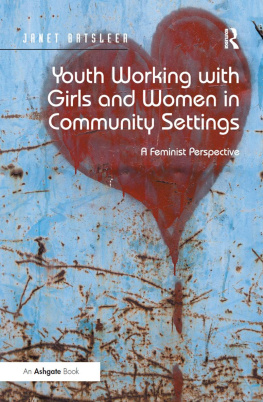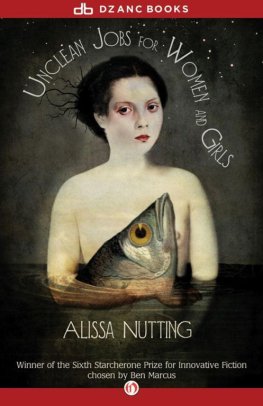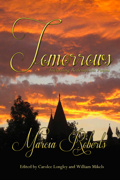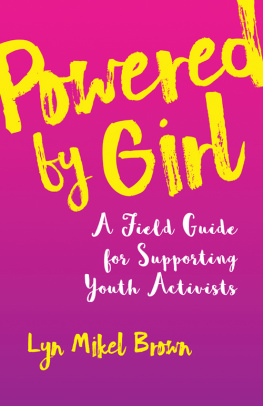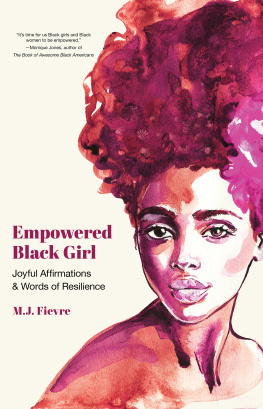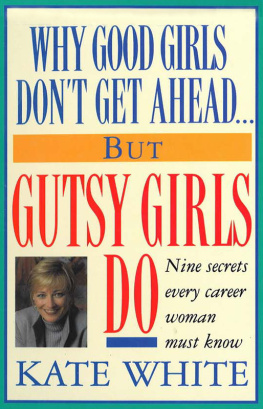First published 2013 by Ashgate Publishing
Published 2016 by Routledge
2 Park Square, Milton Park, Abingdon, Oxon OX14 4RN
711 Third Avenue, New York, NY 10017, USA
Routledge is an imprint of the Taylor & Francis Group, an informa business
Copyright 2013 Janet Batsleer
Janet Batsleer has asserted her right under the Copyright, Designs and Patents Act, 1988, to be identified as the author of this work.
All rights reserved. No part of this book may be reprinted or reproduced or utilised in any form or by any electronic, mechanical, or other means, now known or hereafter invented, including photocopying and recording, or in any information storage or retrieval system, without permission in writing from the publishers.
Notice:
Product or corporate names may be trademarks or registered trademarks, and are used only for identification and explanation without intent to infringe.
British Library Cataloguing in Publication Data
Batsleer, Janet.
Youth working with girls and women in community settings: a feminist perspective. 2nd ed. 1. Social work with teenagers. 2. Social work with women. 3. Teenage girlsServices for. 4. Feminism.
I. Title
362.7083dc23
Library of Congress Cataloging-in-Publication Data
Batsleer, Janet.
Youth Working With Girls and Women in Community Settings : A Feminist Perspective / By Janet Batsleer.
pages cm
Includes bibliographical references and index.
ISBN 978-1-4094-2579-3 (hardback : alk. paper)
1. Young womenServices forGreat Britain. 2. GirlsServices forGreat Britain. 3. Non-formal educationGreat Britain. I. Title.
HV1425.B38 2012
362.83530941dc23
2012029644
ISBN 9781409425793 (pbk)
This book exists because there has been a movement within youth and community work practice, referred to as the girls work movement. It is an attempt to record some of the work that has gone on. More immediately, this book exists because of the encouragement of particular colleagues and the sense that something should be written down. Specific help in the form of supply of documents and references, discussions about particular ideas, reading of early drafts, encouragement to press on and support in domestic and family life came from: Gregory Batsleer, Julian Batsleer, Margaret Beetham, Erica Burman, Sue Campbell, Sylvia Caveney, Kate Clements, Sue Cockerell, Jill Dennis, Sakinna Dickenson, Maureen Green, Steph Green, Lorraine Hansford, Moira Hill, Netta Hughes, Kath Hunter, Rehana Hussein, Julia Keenan, Kate Kirk, Ken Leech, Mary Madden, Lydia Merryll, Debbie Mitchell, Louise Murray, Liz Neat, Cath Nicholls, Carol Packham, Bhaggi Patel, Nikki Patterson, Poddi Peerman, Janet Preece, Mark Smith, Parvinder Sohal, Alima Sonne, Yasmin Sonne, Michelle Walmsley, Viv Whittaker, Vanessa Worrell, Margaret White and Tracy Yankowski.
I would like to thank all the projects whose reports and publications I have drawn from in compiling this book. Where I have drawn on project reports, on group discussions, or on the work of youth and community work students, this is acknowledged in the text. Thanks especially to the Feminist Webs network, acknowledged throughout this book, for encouragement to get on with a second edition: especially, Amelia Lee, Alison Ronan, Sally Carr, Jean Spence, Kimberley Osivwemu, Ali Hanbury, Niamh Moore, Viv Whittaker and Maggie Cole. Feminist Webs participants were interested in the Pearl Jephcott Questionnaire: thanks to all the youth workers who asked young women to complete the revised questionnaire based on Jephcotts original study. Although it is not analysed in depth in this book, a copy of the questionnaire which was completed by 75 young women is attached as an appendix.
Thanks to colleagues in the wider Youth and Community networks too: Finn Cullen, Steph Green, Karen McCarthy, Carol Packham, Diane Watt, Susan Morgan and Jean Spence for interest and inspiration.
Thanks especially to people who have contributed the new case studies throughout this second edition: Alison Healicon, Diane Watt, Kimberley Osivwemu, Ali Hanbury, Amelia Lee and Steph Green.
I am grateful to the Education and Social Research Institute (ESRI) at Manchester Metropolitan University (MMU) for their support, releasing me from some teaching commitments to enable this work to be completed. As the research for this new edition has been ongoing, papers which have been presented include:
J. Batsleer and A. Lee (2010) Youth Work as a Feminist Method: Encouraging Feminist Webs, CRESC (Centre for Research on Socio-Cultural Change), University of Manchester, Feminism and Its Methods: An Inter-Disciplinary Colloquium, July 2010 J. Batsleer (2010) The History of Youth Work with Girls in the UK. Targets from Below; First European Conference on the History of Youth Work and Youth Policy, Ghent, July 2010 J. Batsleer and I. Barron (2010), Social Pedagogy and Social Education. Can they embrace diversity and difference?, Minding the Gap? International Conference on Work with Young People, University of Strathclyde, September 2010; J. Batsleer (2010)From Feminism to Queer and Back Again, Thinking Seriously about youth work with girls and young women, March 2010Youth and Policy Colloquium,, Leeds J. Batsleer ((2011) What Sort of Eyebrow Bar Should I have, BERA National Conference London J. Batsleer (2011) Taking Offence? Making Exception? The Politics of Gender in Work with Young Women in Urban Multiculture, Nordic Youth Research Symposium, Turku, Finland and UCLAN Children and Young Peoples Participation Seminar.
And thanks to Fay Entwistle and Julie Wood for support in preparing the manuscript.
Somehow, youth work and informal education that focuses attention on girls has always been associated with threat. It seems to be a threat to the boys, who have been getting more than their fair share of attention. It seems to be a threat to long-held assumptions about who and what youth work and informal education are for, and to the weve always done it this way school of practice. And it is initially threatening to women, as well as energising, to realise that the way things are is not as inevitable as the weather, but can change.
Yet this practice, which seems so threatening, is itself always under threat. First it was under threat from the boys: banging on the door and demanding to be let in to the girls night. Then the persuasions of supportive professionals were also potentially threatening: There is such a need for progressive and supportive work with boys as well as girls, on sexual health and teenage pregnancy for example. Of course this is true. But because the larger share of budgets still goes to boys, anti-sexist work needs to recognise and respect the power of agenda-setting in autonomous work with girls.
Models of anti-discriminatory and anti-oppressive practice have contributed to the professional formation of informal educators in youth work for more than thirty years. Recognising the impact of patterns of discrimination and exclusion on the lives of young people and communities is essential to any good practice in informal education. There has been significant discussion of group work based in young peoples awareness of specific identities which mean something to them, which matter. Culturally sensitive and culturally specific work has been discussed, as has gender-specific and gender-sensitive work. Autonomous work with girls as it is discussed is a significant stream flowing into the wider river of anti-oppressive practice (Thompson 2006, Ledwith 2011, Batsleer 2008, Young 2006, Banks 2010).


